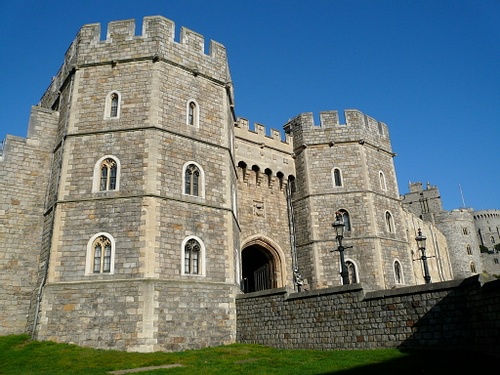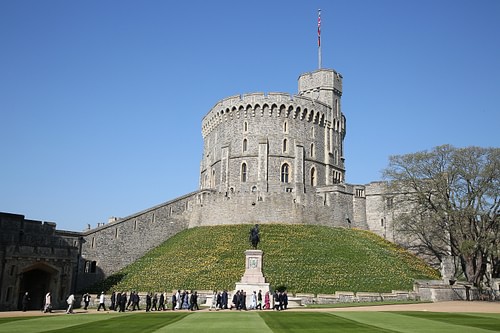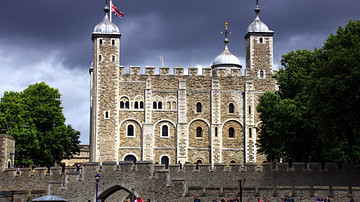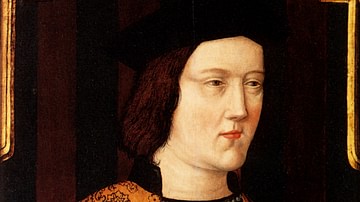
Windsor Castle is located in Berkshire, England, and was built as a motte and bailey castle by William the Conqueror (r. 1066-1087). Converted into stone by Henry II of England (r. 1165-1179), the shell keep tower was rebuilt by Edward III of England (r. 1327-1377). The castle was then added to and modified many times over the centuries.
Although experiencing additions and renovations under every new monarch, Windsor Castle still maintains its original plan of a courtyard either side of a central circular tower. Much more than a castle and a palace, the complex includes Saint George's Chapel, the tombs of 12 British monarchs, and a magnificent library and art collection. Windsor Castle is the largest inhabited castle in the world and was the official residence of Queen Elizabeth II (r. 1953-2022).
Medieval History
Windsor Castle is located in the centre of the town of that name in the county of Berkshire, southern England, some 32 kilometres (20 miles) west of London. The first version of the castle was built by William the Conqueror c. 1070 as a motte and bailey castle overlooking the Thames River, conveniently close to both London and forests for hunting deer. The castle was built using earth and wood to create a raised hill (motte) on top of a steep natural chalk escarpment some 30.5 metres (100 ft.) high and an enclosed area around the base (bailey) formed by a wooden palisade which was itself protected by an outer ditch. Windsor Castle was designed with two baileys (aka wards), one lower and one upper, either side of the motte.
The wooden tower on top of the motte was rebuilt in stone by Henry II in 1170, thus creating a shell keep, which then became known as the Round Tower. The king also built private royal apartments in the Upper Ward and public and ceremonial spaces such as the Great Hall in the Lower Ward. Henry began converting the curtain wall into stone, too, a task completed by Henry III of England (r. 1216-1272), who added three semi-circular towers, including the Curfew Tower, to the Lower Ward's curtain wall.
In the 13th century Windsor Castle was besieged during the First Barons' War (1215-1217) by forces loyal to Prince Louis of France (future King Louis VIII, r. 1223-1226) who rebel barons wanted to enthrone as a replacement for King John (r. 1199-1216) after he reneged on his promises signed in the Magna Carta. The ultimately unsuccessful siege lasted two months but, in the entire southeast of England, only Dover Castle and Windsor remained in the English king's hands during the war. The castle was besieged again in the same century, but repairs were made by Henry III who made the walls an impressive 7.3 metres (24 ft.) thick in places to better withstand the ever-more-powerful catapults being used in siege warfare. The castle was also equipped with sally-ports and tunnels, which permitted the defenders to leave the castle unseen and surprise attackers from behind. One such sally-port, located beneath the Curfew Tower, survives today virtually intact. Henry III also rebuilt the Lower Ward, adding a bigger chapel there, revamped the Upper Ward's royal apartments - where the apartments for king and queen were separated - and added two more chapels there. As a consequence of all this activity, Henry spent more money on the castle than any of his predecessors.
Windsor Castle was now well-established as a primary royal residence and hosted a great tournament in 1278, the vast list of supplies for which are recorded in a fascinating medieval record, the Windsor Tournament Roll. Another great medieval tournament, this time involving 200 knights, was held at the castle in 1344.
An extensive and wildly expensive building and remodelling project was next overseen by Edward III of England in the second half of the 14th century. The Round Tower was rebuilt, the large double-towered gatehouse was added (1357-1359, and now called the Norman Gateway) as an entrance to the Upper Ward, and the castle generally made more comfortable as a royal residence with private apartments. Built in the Gothic style, the Upper Ward was remodelled around three courts while the Lower Ward was given extra accommodation for members of the king's new chivalric order, the Order of the Garter (see below), and the chapel there, in keeping with the order's patron saint, was renamed Saint George's Chapel. Crenellations were added, but these were now only ornamental, the first such use of military design features in English domestic architecture. The whole project cost Edward a massive 50,000 pounds (over $70 million today), more than any medieval English monarch ever spent on a single building.

The early 15th century saw the castle receive one of its more famous prisoners, James I of Scotland (r. 1406-1437), captured at sea in 1405 and interned, albeit in relative comfort, in one of the towers for 11 years. During the second reign of Edward IV of England (r. 1461-70 & 1471-1483) the old Saint George's Chapel was converted into a lady chapel (and then converted again into a memorial for Prince Albert by Queen Victoria). The new Saint George's chapel was begun by Edward and completed during the reign of Henry VII of England (r. 1485-1509). As the medieval period closed, Henry VIII of England (r. 1509-1547) then added the Lower Ward gatehouse that today bears his name and which stands opposite Saint George's chapel.
Saint George's Chapel
Originally built in the 14th century and remodelled in the 15th century in the style known as Perpendicular Gothic, Saint George's chapel is the greatest surviving example of medieval architecture in the castle today and one of the finest castle chapels anywhere. The chapel's east doors were originally made for the now lost King's Chapel built by Henry III in the Upper Ward; the gilded ironwork signed by the smith Gilebertus against the scarlet gesso background makes for a striking entrance. The chapel's most stunning feature, though, is its distinctive fan vaulting ceiling, rendered in stone and added in 1475. Down below, there are the magnificent and intricately carved oak choir stalls (1478-85). The chapel contains the royal tombs within which were interred 12 monarchs, including Henry VIII and Charles I (1625-1649). Queen Victoria (r. 1837-1901), on the other hand, lies in her mausoleum at Frogmore House within the castle's grounds. The horseshoe-shaped court of the chapel has cloisters and accommodation for members of its clergy and choir. Saint George's Chapel is a Royal Peculiar, which is to say it is subject to the monarch and is not part of any diocese.
The Order of the Garter
Around 1348 Edward III created a new chivalric order, The Most Noble Order of the Garter which is the highest order of knighthood in Britain and the most exclusive with traditionally only 24 knights as full members at any one time, along with the reigning British monarch and the Prince of Wales. The order's headquarters and host of its annual gathering is Saint George's Chapel. In the medieval period, and in keeping with chivalric ideals, the castle also hosted 26 'poor knights' who were given free clothes, food, and lodgings there.

Every year on a Monday afternoon in mid-June (previously on Saint George's Day in April), a magnificent procession of members and retainers in full regalia maintains the traditions of medieval pomp and pageantry as they walk from Saint George's Hall to the Chapel. If there are to be any new knights invested in the order, there is a morning service in the castle's Throne Room. The coat of arms of a member, which may have to be created by the Royal College of Arms if the holder does not yet have one, is hung in Saint Georges' Chapel above that member's private stall.
Later History
The castle saw many significant changes after the medieval period. William I built his castle on rented land from a fellow Norman noble but the monarchy did finally buy the castle outright in 1546. A century later, the very fact that the castle was a royal property led to the victorious Parliamentarians looting Saint George's Chapel and the royal apartments following the English Civil War (1642-1651). The Upper Ward was used as a prison for royalists and the Windsor Great Park was sold off in parcels, amongst other indignities suffered by the castle. Following the Restoration of the monarchy (1660), Charles II of England (r. 1660-1685) was the next ruler with big building plans, and he added new apartments in the baroque style to the Upper Ward. Charles also created a 4 km (2.5 miles) walk lined with elms from which to admire the castle at a distance.
In the 17th century, some of the apartments within the castle were opened to the public for the first time, and the very first guide book was published in 1749. In the 19th century, the castle was restored by George III (r. 1760-1820), who notably created the Garter Throne Room and restored Saint George's Chapel. Then George IV (r. 1820-1830) increased the height of the Round Tower by one storey, rebuilt the private apartments in the neo-Gothic style and added the castle's now main entrance, the George IV Gate. Largely completed by 1835, Queen Victoria spent more time at the castle than any other residence. Indeed, one of her popular nicknames was the 'Widow of Windsor' following the death of her husband Prince Albert, whom she had met for the first time at the castle in 1839.
During the First World War (1914-1918) the German links of the British Royal family, then known as the House of Saxe-Coburg-Gotha, were carefully played down, and one notable change was, from 17 July 1917, to adopt the name Windsor, after the castle. Later in the century, King Edward VIII of England (r. Jan-Dec 1936) famously made his abdication speech from the castle. The ex-king's partner Wallis Simpson was made Duchess of Windsor and both would be buried in the royal tombs of the castle. The castle, fortunately, survived the bombings of the Second World War (1939-1945) when many artworks were removed for safekeeping and an air-raid shelter was added to the basement of the Brunswick Tower. Conversely, some treasures were brought to Windsor for safety such as the most precious stones from the Crown Jewels like the Black Prince's Ruby, buried in the castle grounds inside a biscuit tin.
The Castle Today
Windsor Castle covers some 13 acres (5.2 hectares) and, the official residence of Queen Elizabeth II, it is the largest inhabited castle in the world. The royal court usually stays in the castle from April to June, but more permanent residents, in what resembles more a fortified village than a castle, include the Constable, governor, the knights of Windsor and their families, and a Household Regiment battalion (aka 'the Guards'). Windsor is also home to a huge art collection and the Royal Library. Fine artworks which have their home here include An Old Woman by Rembrandt (c. 1609), Holy Family with Saint Francis by Rubens (c. 1630), Charles I in Three Positions by Van Dyck (c. 1635), as well as numerous works by Canaletto, countless other paintings and a remarkable collection of drawings by such renowned artists as Michelangelo, Albrecht Dürer, and Leonardo Da Vinci.
On 20 November 1992 tragedy struck when a fire, perhaps caused by a spotlight igniting a curtain, began in the Private Chapel. The fire raged for 15 hours and spread to destroy the north-east corner of the Upper Ward, gutting the Grand Reception Room and Saint George's Hall where state banquets were (and still are) held in alternation with Buckingham Palace. Fortunately, most damaged rooms were empty at the time as they were undergoing rewiring work so that surprisingly few artworks were lost. One of the bright spots of the disaster was the discovery that the two-storey Great Kitchen with its enormous fireplaces, when cleared of several covering buildings, was in fact mostly a 14th-century original and not, as previously thought, a much more modern addition. The building is one of the oldest still-in-use kitchens in the world. Extensive repairs and restoration work were carried out throughout the castle, which was all completed by 1997. The castle then regained its role in state ceremonies and once more faced the international limelight in May 2018 when St. Georges' Chapel hosted the live televised wedding of Prince Harry, Duke of Sussex and Miss Meghan Markle, Duchess of Sussex.






